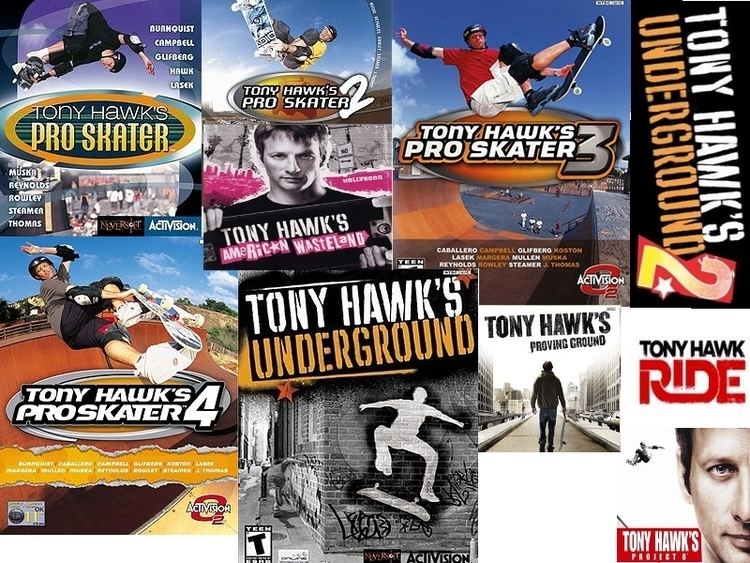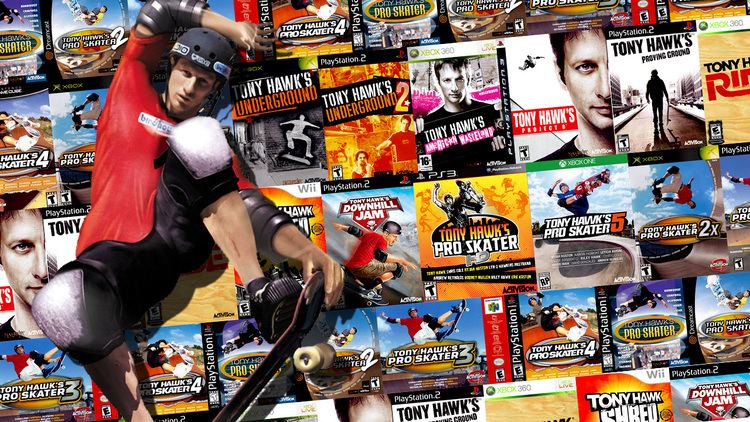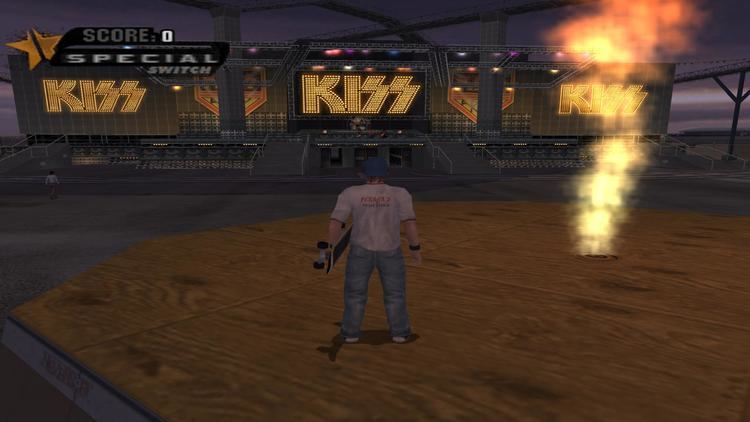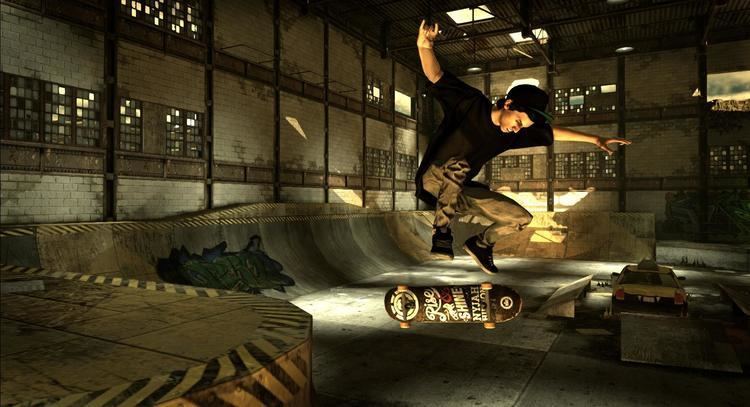Publishers Activision (1999–2015) Publisher Activision (1999–2015) | Platform of origin PlayStation | |
 | ||
Developers Neversoft (1999–2007)
Vicarious Visions
(Handheld; 2001–2007)
Robomodo (2008–2015)
Other
Edge of Reality
Natsume
Treyarch
Shaba Games
HotGen
Gearbox Software
Beenox
Visual Impact
Toys For Bob
SuperVillain Studios
Page 44 Studios
Creat Studios
Buzz Monkey
Big Bit
Disruptive Games Platforms PlayStation
PlayStation 2
PlayStation 3
PlayStation 4
PlayStation Portable
Nintendo 64
GameCube
Wii
Game Boy Color
Game Boy Advance
Nintendo DS
Dreamcast
Xbox
Xbox 360
Xbox One
Microsoft Windows
Macintosh
N-Gage
iOS
Android First release Tony Hawk's Pro Skater
August 31, 1999 Latest release Tony Hawk's Pro Skater 5
September 29, 2015 Designers Activision, Neversoft, Leo Zuniga Genres Sports game, Adventure game, Platform game, Racing video game Games Tony Hawk's Pro Skater 5, Tony Hawk's Shred Se, THUG PRO, Tony Hawk's Pro Skater HD, Tony Hawk: Shred | ||
Tony Hawk's was a skateboarding video game series endorsed by professional skateboarder Tony Hawk and published by Activision from 1999 to 2015. The series was primarily developed for home consoles by Neversoft from launch to 2007, until Activision transferred the franchise to Robomodo in 2008. At the time the licensing deal between Activision and Hawk expired in 2015, the series has spawned a total of 19 games.
Contents
- Background
- Neversoft era 19992007
- Robomodo era 20082015
- Post Activision 2015present
- Gameplay
- Pro skaters
- Guest appearances
- Reception
- References
Starting out with the initial Tony Hawk's Pro Skater in 1999, the series proved to be one of the most popular and best-selling video game franchises of the early 2000s. Three more Pro Skater games were released from 2000 to 2002, after which the developers took a more story-oriented approach with the releases of Underground, Underground 2 and American Wasteland from 2003 to 2005. Project 8 in 2006 and Proving Ground in 2007 were the last games in the series developed by Neversoft. After that, new developer Robomodo took the franchise in a different direction by developing the peripheral supported spin-offs Ride and Shred, released in 2009 and 2010, respectively. Both were commercial and critical failures. Robomodo tried to revive the series with the back to the roots-oriented releases of Pro Skater HD and Pro Skater 5 in 2012 and 2015. Furthermore, the series spawned several other spin-offs, such as Downhill Jam in 2006, Motion in 2008, and Shred Session in 2014, along with several ports and re-releases.

The first five Tony Hawk's received critical acclaim for their unique gameplay, varied soundtracks, and expansion over their predecessors. Tony Hawk's Pro Skater 2 and Pro Skater 3 are critically ranked among the best games ever released for the PlayStation and PlayStation 2, respectively. However, later entries started getting less favorable reviews, culminating in the games developed by Robomodo being critically panned, with Ride and Pro Skater 5 being named "Worst Games of the Year" by several outlets.

Background

In 1998, Activision signed professional skateboarder Tony Hawk as the face of the skateboarding game Tony Hawk's Pro Skater. The game had been in development before Hawk was signed as the face of the brand and his name and likeliness were included late in development. Originally, Hawk signed a licensing contract valid until 2002, which was renewed until 2015, following the success of the Pro Skater series. Mitch Lasky, at that time senior vice president of Activision, stated in an interview with GameSpot that the game as well as the character were meant "to reflect Tony's signature style – an intense mix of acrobatics and hard-core technical skating". Hawk himself was involved in the development of the game and his in-game persona, remarking that "[he had] always wanted to help create a video game that represented the reality and excitement of professional skateboarding". Hawk, along with other skaters featured in the game, was animated for the game using motion capture and voiced his character.
Neversoft era (1999–2007)

In early 1998, Activision approached small developer Neversoft to develop a skateboarding game, in order to capitalize on the growing popularity of the sport. To make the gameplay seem as real as possible, company founder Joel Jewett had a halfpipe built in his backyard and started skateboarding with his coworkers. Also, motion capture was used to make the skateboarding moves seem as realistic as possible. To distance the franchise from other games, the developers opted for licensing modern rock songs, in contrast to the classic music usual for video games at that time. The first game was developed within a year by a 12-person team, and Tony Hawk was added as the face of the franchise only late in development. All skaters featured in the first entry received around $190.000 in royalties. A month before the release of Tony Hawk's Pro Skater for PlayStation in 1999, Hawk successfully performed a 900 at that years X-Games, which resulted in huge press coverage of the sport and helped boost sales of the title. The huge success of the game prompted Neversoft to vastly expand its production staff in order to be able to release Tony Hawk's games on a yearly basis. Neversoft held true to that ambition and released Pro Skater 2 and Pro Skater 3 in 2000 and 2001. Both games retained mostly the same gameplay as their predecessor, along with some improvements. The two games were the most critical acclaimed games for their respective consoles and still rank among the highest rated games of all time. Furthermore, Pro Skater 3 was the first PlayStation 2 game to feature online gameplay. Also, Tony Hawk's Pro Skater 2x, a compilation of the first two games, was released for Xbox in 2001, as the console had not featured the previous entries before. 2002 saw the release of Pro Skater 4, by which time the franchise was among the best-selling video game franchises in the world. This was reflected in the manpower Activision and Neversoft invested in the franchise, as the employees working on the game had risen from 12 for the first entry to 150 and there were significantly more skaters featured, who all received considerable royalties.
With the 2003 release of the fifth entry in the series, Underground, the developers used storytelling and exploration to distance their product from the plotless, task-based format of previous Tony Hawk's games, which led Neversoft president Joel Jewett to describe Underground as an adventure game. The game was created with a theme of individuality: it stars an amateur skater in a true story mode, whereas each previous Tony Hawk's game had starred professional skaters and had lacked a plot. One reason for only allowing the player to use a custom character was that certain criminal acts completed in the plot would not reflect well on real-world skaters. Previous games in the series had included character-creation features as well, but Neversoft expanded customization in Underground by implementing face-scanning for the PlayStation 2 version. Regarding the customization options, especially the park editor, producer Stacey Drellishak stated that Neversoft was "trying to create the most customizable game ever". Levels in the console versions of Underground were significantly larger than those of earlier Tony Hawk's games. Neversoft expanded each level until it ceased to run correctly, then shrunk it slightly. Most of the levels were modeled closely after real-world locations; the designers traveled to locales representative of each city in the game and took photographs and videos as reference. Neversoft wanted the player to become familiar with the basic game mechanics quickly and to notice Underground's differences from previous Tony Hawk's titles, who all stuck to roughly the same pattern, immediately. To accomplish this, they introduced the player to foot travel and the ability to climb along ledges in the first few missions of the game. While Neversoft wanted to keep Underground realistic and relatable for the most part, they added driving missions as an enjoyable diversion and to push the boundaries of freedom in skateboarding games. However, these missions were intended not to take away from the main experience of skateboarding. Because Pro Skater 4 had received criticism for its difficulty, Neversoft added four difficulty settings to Underground's story mode. Tony Hawk's Underground 2, released a year after its predecessor, was the only direct sequel in the series. While it still featured a story mode, it took a stark departure from Underground and focused on a "World Destruction Tour" orchestrated by Tony Hawk and Bam Margera. As such, the game tried to capitalize on the immense popularity of Jackass and it's related media by also focusing on destruction and self-depreciating pranks. One later review referred to the game being "more of a Jackass game than the Jackass game." This was reflected by the Jackass stars Jason "Wee-Man" Acuña, Stephen "Steve-O" Glover, Margera and his father Phil featuring heavily in the game. Due to some fans being displeased with the absence of the goal-oriented approach of the Pro Skater era, a "Classic Mode" showcasing the old gameplay was included from this entry onwards. The PlayStation Portable exclusive Tony Hawk's Underground 2: Remix contained different levels and a slightly different story and was released during spring 2005.
In 2005, American Wasteland was released on the PlayStation 2, Xbox, GameCube, Xbox 360 and later on PC. The game's story mode is set in the city of Los Angeles, where the player character is trying to renovate a run-down skate park. While the game was advertised with featuring one huge comprehensive open world in story mode, the game's world actually comprised several levels, resembling different areas of Los Angeles, which were connected through loading tunnels to make them appear consecutive. Similar to Underground 2, the game includes a classic mode separate from the story mode, which mostly recycles levels of the PSP-exclusive Underground 2: Remix, released earlier that year. Furthermore, the game implemented BMX controls similar to the Mat Hoffman's Pro BMX games, which were also released by Activision. Also similar to its predecessor, the game was accompanied by American Sk8land, a handheld game for Nintendo consoles with slightly different story and levels. The promise of an open world skateboarding game was fulfilled with the next entry in the series, Project 8, released in late 2006. While the PS2 and XBox versions did not feature said open world, seventh generation of video game consoles, such as the PlayStation 3 and XBox 360 could support huger content. Once again, the game's story centered on the player character aspiring to become a professional skateboarder, this time by advancing through a rank system to become a part of Tony Hawk's new fictional skateboarding team, the namegiving "Project 8". Unlike as with previous entries, the classic mode was embedded in the different areas of the open world. The game did not appear on Nintendo's new Wii console, which instead saw the release of the then-exclusive spin-off game Downhill Jam, a downhill racing game featuring a mostly fictitious cast. The game was also released on PS2 half a year later. The next title in the main series, 2007 Proving Ground featured a largely similar concept to Project 8, with an open world and the player able to choose three career paths as a skater. Baltimore, Philadelphia, and Washington, D.C. were established as the three open world areas, with each containing three skateable areas, which also featured an integrated classic mode. The game was the first and only entry of the series to compete with rival skateboarding series Skate, which also featured an open world but with more advanced controls and a less arcade-like approach. Skate outsold Proving Ground on a 2:1 ratio, resembling its lackluster reception. With the franchise suffering from product fatigue and appearing to be past its prime, Activision decided to dedicate most of Neversoft's laborforce to the Guitar Hero and Call of Duty franchises. This development would more and more marginalize Neversoft, which was defunct and completely merged with Infinity Ward by 2014. The control of the Tony Hawk's franchise had passed on to Chicago studio Robomodo by 2008.
Robomodo era (2008–2015)
Motion, a spin-off to the franchise, was released for the Nintendo DS on November 18, 2008. Motion utilizes gameplay incorporating tilt/motion controls. The game also featured the option to snowboard. Another spin-off of the franchise, Ride, was developed by Robomodo, and released in November 2009 for the Xbox 360, Wii and PlayStation 3 to poor critical and commercial reception. The game uses a board peripheral that uses accelerometers and sensors to create a more realistic experience. The board itself received negative criticism from reviewers. Tony Hawk mentioned on Twitter the existence of the next game, a direct sequel to Ride, reportedly titled Shred. The game was officially announced by Activision on April 22, 2010. The game was released on October 26, 2010. The game received poor reviews from critics and fans.
On February 9, 2011, Activision announced that the series would not feature an installment in the 2011 calendar year. This was due to poor reviews and sales of recent games in the series. Tony Hawk has since stated that "we're going to do something probably for next year but I can't give too much away" regarding the 2012 calendar year. Activision's CEO of publishing has stated that they believe in the staying power of the Tony Hawk franchise, claiming that Tony Hawk "is a lasting icon. He has that Michael Jordan-ish or Jordan-esque staying power, seemingly." A remake, Pro Skater HD, was released on July 18, 2012.
On October 30, 2013 in an interview with CNBC, Hawk discussed plans for a future entry to the series. Hawk later confirmed that the new entry to the series would be a mobile exclusive spin-off, Shred Session. Shortly after its soft launch in 2014 the game was postponed indefinitely and removed from the markets it had been released in.
The first main entry to the series since 2007 was revealed in an article published by Game Informer on May 5, 2015. The tenth entry in the series, Pro Skater 5, was released on PlayStation 4 and Xbox One on September 29, 2015, with PlayStation 3 and Xbox 360 versions released on December 15, 2015. The game was panned heavily by critics upon release, noting its numerous technical issues, simplistic missions, bland environments, environmental clipping, and physics issues.
Post-Activision (2015–present)
The licensing deal between Hawk and Activision expired in December 2015. Since it's discontinuation, the Pro Skater fanbase has largely sustained itself through THUG PRO, a fan-made mod of Underground 2 for Microsoft Windows, macOS, and Linux, that features levels of every game in the series for use in online multiplayer.
In January 2017, Hawk confirmed in an interview that he is in early talks to continue the franchise without Activision and that he was interested in using virtual reality for his next game.
In March 2017, a documentary about the Pro Skater series was announced by former Neversoft employee and producer of the series, Ralph D'Amato. The documentary, titled Pretending I'm a Superman: The Tony Hawk Video Game Story, features interviews from former Neversoft employees as well as skaters featured throughout the series, including Hawk himself. It is named after the song "Superman" by Goldfinger, a song commonly associated with the first Pro Skater. Pretending I'm a Superman is planned for a May 2018 release.
Gameplay
The Tony Hawk's series was originally developed as a classic arcade game. The goal of most modes of the game is to achieve a highscore. To do this, the player has to successfully perform and combine aerials, flips, grinds, lips, and manuals, with successful executions adding to the player's score. The point value of the trick is based on time maintained, degrees rotated, number of tricks performed in sequence, performing tricks on specific landmarks on the map, and the number of times the tricks have been used. Successful tricks also add to the player's special meter, which, once full, allows for the execution of special tricks which are worth a great deal more than normal tricks. Bails (falling off the skateboard due to poor landing) cause for no points to be awarded for the attempted trick and resets the special bar to empty. The controls of the game developed further the more the series progressed. While the original Tony Hawk's Pro Skater featured a fairly limited set of moves, later entries allowed the player to switch between moves during the same grind or manual sequence, perform transfers, hold on to and drive various vehicles, walk on foot and scale walls, slowing time, or performing more advanced tricks by pressing buttons repeadedly, for example a double or triple kickflip instead of a normal one. Later entries, such as American Wasteland, allowed the player to also use a BMX, whereas Motion and Shred featured snowboarding.
The first three Pro Skater games centered around an arcade mode, in which the player is tasked with achieving a highscore, perform certain tasks and collect a number of objects in a limited amount of time. If the player completes enough of these objectives in one level, he unlocks other levels and acquires currency, with which he can improve his character. Also, there are competition levels, in which the player does not have to collect any objects, but perform an excellent score with minimal bails in order to progress. Starting with Pro Skater 2, it was also possible to create a custom character and design individual skateparks. Furthermore, all games until Pro Skater 5 featured local multiplayer, while it was possible to compete in online multiplayer since Tony Hawk's Pro Skater 3. From the first Pro Skater onward, it was possible to access all levels without having to perform tasks and without time limit. This concept was later used in career mode from Pro Skater 4 onwards. From now on, NPCs gave tasks to the player, who could otherwise freely explore the levels without time constraints. Starting with Underground, the series replaced the career mode with a proper story mode. In Underground, Project 8, and Proving Ground, the story centered around the player character turning into a professional skateboarder. In Underground 2, the only direct sequel in the series, on the other hand, the player embarks on a destruction tour around the world, orchestrated by Tony Hawk and Bam Margera. In American Wasteland, which was the first entry to feature one consecutive open world instead of separate levels, the player character intends to rebuild an old skatebark in Los Angeles.
After Activision moved the series from Neversoft to Robomodo, the new developer significantly changed the general outlet and gameplay of the franchise. Tony Hawk: Ride and its successor, Shred introduced a peripheral skateboard which replaced the controller. Aiming to provide a realistic skateboarding experience, turning, leaning, hopping, and other actions on the peripheral device were directly translated into the movements of the in-game character via infrared sensors. However, this resulted in the abandonment of open levels, which were replaced by linear levels that had the character skate on pre-set paths. A similar attempt was made with the Nintendo DS game Motion, which used a peripheral device that recognized the leaning of the DS system and had the skater move accordingly.
Pro skaters
Note: Shaded cells represent unlockable skaters.
Guest appearances
These are unlockable characters that have made guest appearances in the Tony Hawk games, while most are real-world celebrities and musicians, others come from properties and licenses that Activision or Neversoft held at the time.
Reception
The first five games in the series received critical acclaim for their unique gameplay and varied soundtracks. Pro Skater 2 was met with widespread critical acclaim and commercial success. According to GameRankings, it is one of the highest rated video games of all time and one of the highest ranking video games of fifth generation for PlayStation, holding the score of 94.75%. It also holds a score of 98, making it one of the highest rated video games of all time across all consoles and platforms, on Metacritic, ranked second behind The Legend of Zelda: Ocarina of Time.
Pro Skater 3 sold 2.4 million copies worldwide and received a widespread critical acclaim, being one of the few games that has received a perfect "10" score from GameSpot, and the top rated PS2 game on the review aggregate website Metacritic, with an average score of 97/100, tying with Grand Theft Auto III. IGN stated that "Tony Hawk's gaming legacy is one he can be proud of" amidst other video game incarnations of celebrities.
After the release of Underground 2, the games have been slightly less well received. IGN ranked Hawk on its February 2009 list of the top ten video game characters who should die, rationalizing that "we are in no way advocating the death of the real Tony Hawk... But killing him in one of his final game outings – that would be just plain hilarious."
